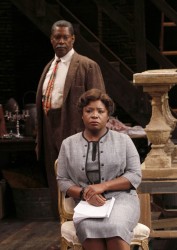Director Valerie Curtis-Newton and the Lorraine Hansberry project have done Seattle audiences the great service of bringing Alice Childress’ Trouble in Mind to the stages of Intiman’s Summer Theatre Festival. This production is a triumphant realization of what may well prove to be the playwright’s most important contribution to the theatre and to history: a searingly truthful, slice-of-life play capturing the lives of Broadway actors in rehearsal, and revealing the workings of racism in America.
With a near-perfect company of gifted actors, and designs that brilliantly create a theatre within a theatre, we are transported to a world that is historicized by time and place, and yet eerily and tragically contemporary. The time is 1959, the place is backstage, the people are the black and white actors, their director, his assistant, and naturally, the theatre’s doorman. The activity revolves around rehearsals of a play which tells the story of a lynching, a project the (white) director thinks will make his career, and one which suffocates the truthful voices of the African American characters it claims to represent. What transpires is an exorcism of truths, a peeling back of the skins of lies, distortions, masks and manners of self-protection and deception that become critically necessary for black folks in a racist world, and the privilege of whites who cannot begin to understand, much less accept, how their own racisms might operate.
At the center of the action is Wiletta (Tracy Michelle Hughes), a black actress who has seen more than her share of musicals and whose passionate desire to succeed in her chosen field drives her to accept whatever work comes, regardless of her feelings about the material. She has taken a role without reading the play and as the other black members of the company arrive, makes it clear to the young newcomer John (the intuitive Andrew Lee Creech) that under no circumstances will she, nor should he, say what they think about the script. Childress was masterful at capturing the voices of the self-important white director (a perfectly calibrated Tim Gouran), and his assistant-with-a-conscience (the understated Adam Standley) making it clear that Childress was listening keenly to the dominant white mens’ voices surrounding her. Other actors arrive. Millie Davis (the razor-sharp Shontina “Tina” Vernon) is a younger black actress, and Sheldon Forrester (a big Seattle “Welcome Back!” to the marvelous G. Valmont Thomas), is an old timer whose “Uncle Tom” act is so deft a mask that when he finally lets it fall, it is one of the most astonishing and moving moments of the action. Judy Sears (Skylar Tatro) is the young white actress who is to be the ingenue of the new play. The second act brings us Bill O’Wray (the versatile Mark Anders), a well-established white actor who thinks he can float above the conflict and who doesn’t want to mix with the black folks if he doesn’t have to.
I am not going to reveal the workings of the plot, or how the play within the play generates the explosive confrontations necessary to ignite courage, resistance, utterances of truth, and the possibilities of personal and societal revolutions. The theatre is a very real place, but it is also a metaphor for a world in which the masking of truth, and the truth behind the mask become the most powerful kinds of vehicles for storytelling. Backstage plays, that have a play within the play, and actors playing actors, who are playing actors…..let’s just say the theatre is a powerful place to tell one’s story.
Childress knew that oppressed peoples can recognize each other across chasms of difference, and it is a testament to her wisdom that she allows Wiletta to build a fragile trust with Henry, the aging Irish doorman (Burton Curtis). Henry started as an electrician, but we find him scuttling in from the dark corners of the theatre as though he lives there, and like many doormen of Broadway theatres today, seems ageless. Nothing can happen unless Henry opens the door of the old building, but after that, the Irishman is expected to disappear into the woodwork like a servant. In their scenes together, Hughes and Curtis find the connection that is possible between people who share the same kinds of scar tissue covering wounds left by cruel oppression.
This is an ensemble project and by that I mean that the writer crafted a text in which every character has a meaningful and clear journey. But the soul of the work lies in the struggles of Wiletta, Childress’s surrogate. Tracy Michelle Hughes‘ performance is a pressure cooker of intense longing, repressed emotions, boiling rage, calculated strategies, and finally, raw vulnerability through which truth is allowed to flow. Hughes‘ performance is virtuosic, and her moments alone onstage when she first enters the empty Broadway theatre, and at the end of the night, when she comes to the edge of the stage again, released from one kind of oppression but not quite delivered, brought chills to me, and I would guess, every person in the refreshingly diverse audience opening night.
Set designer Jennifer Zeyl, and costume designer Melanie Taylor Burgess worked together to create a backstage world that is perfectly1959, yet also, as the theatre must be, timeless. The clothes were perfect in every detail and color, and Lighting Designer Andrew K. Smith managed to create both the musty and dark backstage rehearsal space, while also illuminating the actors’ every action, gesture and facial expression.
Curtis-Newton reminded me that Childress wrote this place over a five year period, and set the play several years into the future of its Off-Broadway opening (1955). Childress herself was struggling to have her work produced on Broadway, and in refusing to alter the ending of a play (perhaps this one), was shut out of career success. Though she was to be the first African American playwright to receive an Off-Broadway award (the Obie), fifteen minutes of fame was nowhere near enough for this prescient writer, who fell into obscurity and whose works (including Wine in the Wilderness) are shamefully neglected. I confidently predict that Curtis-Newton’s production at Intiman will become definitive, and may ignite a revival of Childress’ s plays all over the country.

















